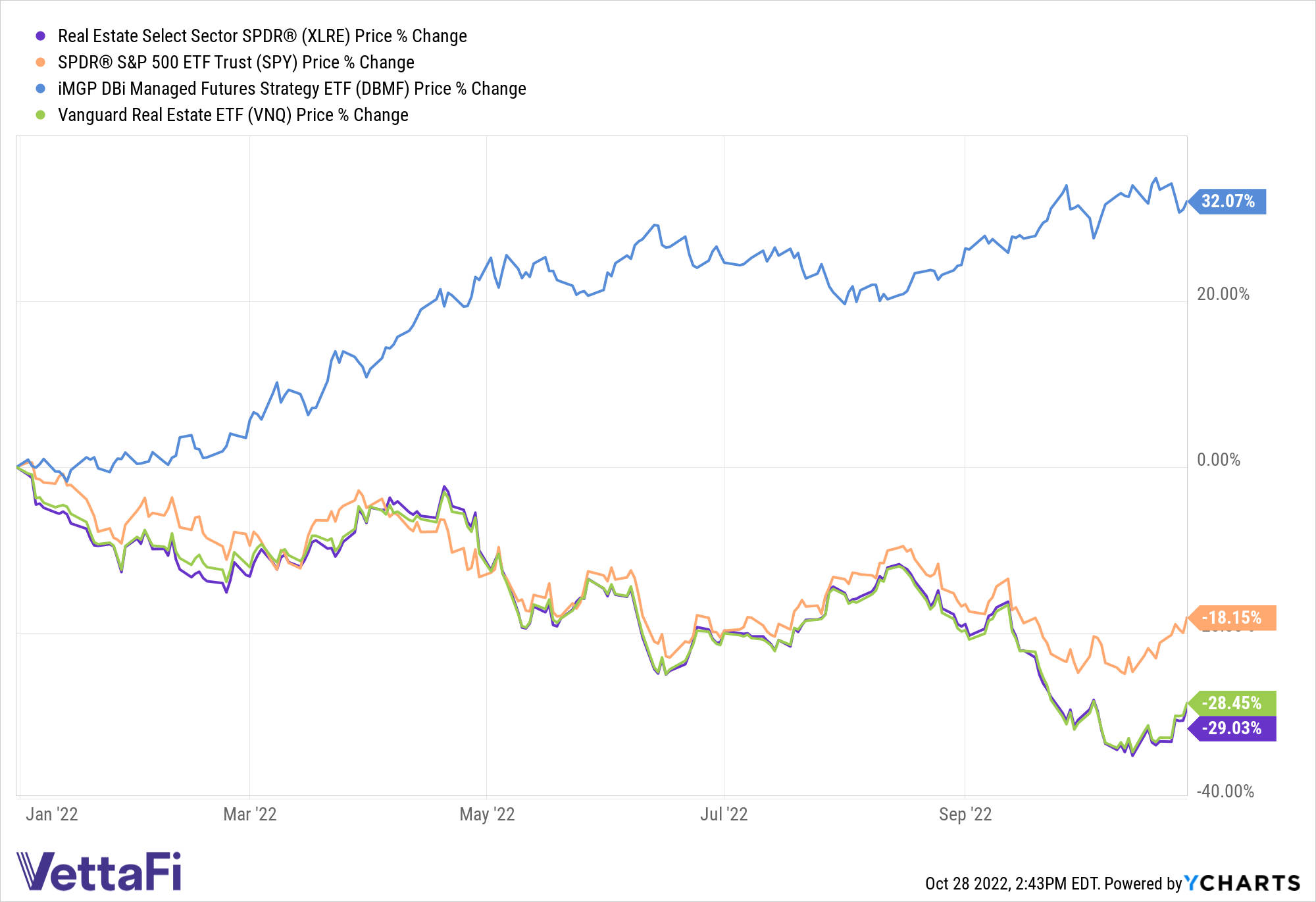Real estate has had a historical role as a 3%–5% diversifier within equity and bond portfolios, but in the changing and challenged markets of 2022, real estate investment trusts (REITs) and the real estate sector broadly have proven to be fairly correlated to equities. Given both the outperformance of managed futures, a trend-following strategy that invests in the futures market, and the lack of correlation of futures to equities and bonds, the case could be made that managed futures now occupy that 5% diversifier sleeve within portfolios.
Advisors and investors have long used REITs — publicly traded companies that finance, own, or operate properties that produce income — and the real estate sector as a means to seek income and dividends, but also as diversification sleeves in their portfolios because of their historically low correlation to both equities and bonds. This role of REITs as portfolio diversifiers (and even as an individual asset class) has been questioned increasingly in recent years, and by looking at real estate’s performance this year, it has become clear that REITs are neither an optimal nor an effective diversifier in the changing market regime of 2022.
Real estate has historically been lumped into financials within indexes, but that changed in 2016 when the S&P 500 broke real estate out into its own sector. That sector now accounts for about 3% of the S&P 500, and in the changing market regime of 2022, that sector is moving analogously to the broader index.

For advisors and investors who are accustomed to slotting real estate into the diversification sleeves of their portfolios as an alternative to equities, it’s proved to be, well, a bit disappointing this year. The Vanguard Real Estate ETF (VNQ) has moved almost in lockstep with the S&P 500 this year — captured via the SPDR S&P 500 ETF Trust (SPY) in the above graph. The sector-specific Real Estate Select Sector SPDR Fund (XLRE) has performed slightly better but generally has trended very similarly to the S&P.
REITs Lean Into Innovation
The current correlation between REITs, equities, and bonds could be part of the larger trend that has seen many of the major asset classes challenged this year, with REITs feeling the heat of rising interest rates similarly to bonds but with increasing equity exposures.
One look at the U.S. real estate market right now reveals the carnage already happening for individual homebuyers as mortgage rates climb. Pending home sales in September were at their lowest rates since June 2010 (excluding the April 2020 COVID-19 crash), down 31% year-over-year. Rising mortgage rates for individuals and businesses will continue to take their toll across the real estate industry in the coming months and potentially beyond as the Fed looks to raise rates and sustain them long enough to bring inflation down close to the 2% target.
Looking beyond what’s happening in the individual homeownership market, REIT companies are increasingly pushing into the areas of the new digital economy such as e-commerce, science, and technology that could be creating greater exposure and linkage to the performance of those sectors.
“REIT ETFs have increasing exposure to growth and innovation-oriented businesses tied to communications and data centers. It’s this increased exposure to innovation that could be the beginnings of greater correlations between the real estate sector and technology and other growth-centric sectors over time, though that remains to be seen,” hypothesized Todd Rosenbluth, head of research at VettaFi.
It’s this kind of exposure that has institutional investors increasingly turning to REITs as a means to gain access to these budding property sectors, John Worth, Nariet executive vice president of research and investor outreach, told Pensions and Investments. At the end of the day, that still leaves the fact that REITs remain increasingly correlated to equities, despite their income and dividend potentials.
The Case for Managed Futures
Alternatives have become an increasingly popular investment in 2022 when equities, bonds, and just about every other traditional allocation has floundered. One of the strongest-performing alternatives this year has been managed futures that invest in the futures market and take long and short positions on a variety of asset classes.
“Once upon a time, it was ‘stocks, bonds, and real estate.’ That worked beautifully when interest rates marched inexorably lower; not so much today,” Andrew Beer, co-portfolio manager of the iMGP DBi Managed Futures Strategy ETF (DBMF), and managing member of Dynamic Beta investments, the subadvisor for the fund, told VettaFi. “In 2023, you’ll start hearing a lot more about ‘stocks, bonds, and managed futures.”
Managed futures have been dubbed the crisis alpha generators, performing their strongest in times of market stress and dislocation, but their ability to perform isn’t limited only to times of volatility and market stress. Because of their non-correlation to equities and bonds, they present portfolio diversification opportunities in any market, with a return stream that is agnostic to which way markets are moving.
“Managed futures hit the trifecta: strong gains during the dotcom, GFC, and Powell bear markets. Not true for real estate — let alone commodities, hedge funds, or the myriad of other diversifiers out there,” Beer said. “Real estate was a great hedge until valuations rose to nosebleed levels as yield-hungry investors bid up prices. A lesson in the importance of picking your entry point.”
There are several managed futures ETFs on the market, but the most popular and largest by far is the iMGP DBi Managed Futures Strategy ETF (DBMF) with over $1 billion in AUM and a five-star rating from Morningstar. DBMF is an actively managed fund that uses long and short positions within futures across domestic equities, fixed income, currencies, and commodities (via its Cayman Islands subsidiary).
It utilizes its own proprietary, quantitative model to determine the allocations of the average of the 20 largest managed futures hedge funds but seeks to replicate their performance, not their positions. By taking the average of the hedge funds, it eliminates single manager bias and risk while providing access to a strategy previously only available to institutional investors.
DBMF has a management fee of 0.95%.
For more news, information, and strategy, visit the Managed Futures Channel.

